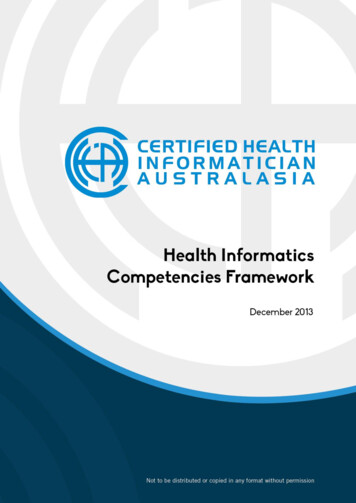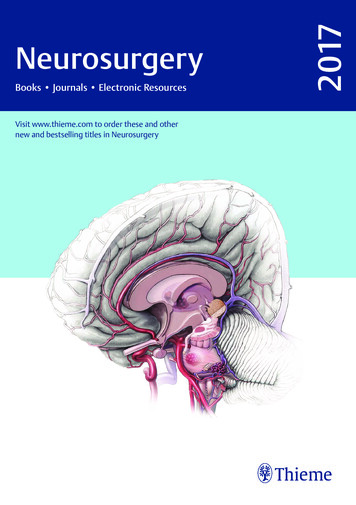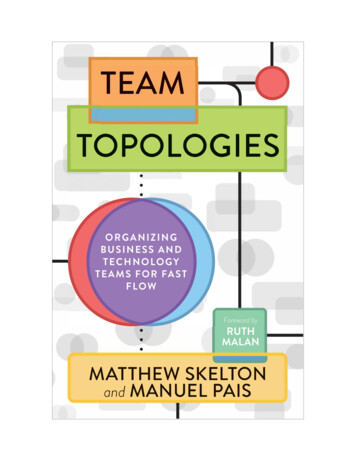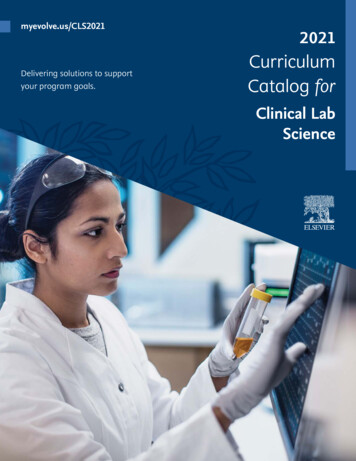
Transcription
Health Informatics Competencies FrameworkEdition 1.0December 2013ISBN: 978-0-9751013-1-5Health Informatics Society of Australia LtdABN: 80 097 598 742ACN: 097 598 7421A / 21 Vale StreetNorth Melbourne VIC 3051Australia 61 3 9326 certification.comProduced in AustraliaAll rights reserved. No part of this publication may be reproduced or transmitted in any form,or by any means, electronic or mechanical, including photocopying, recording, or anyinformation storage and retrieval system, without permission in writing from the publisher. Copyright 2013 Health Informatics Society of Australia
Health InformaticsCompetencies FrameworkEdition 1.0December 2013CHIA. Formal recognition of health informatics knowledge and skills
Table of ContentsAcknowledgements . iiPreface . 1What is certification?. 1Why is certification important? . 1What is the relationship of this health informatics competency framework with the CHIA program? . 1An introduction to health informatics competencies . 2What are competencies . 2How the competencies are to be used . 2Competencies for health informatics specialisations . 2Health Informatics Competencies Framework - Rationale . 3Background . 3Motivation to redraft the Health Informatics Competency Framework . 4Comparative analysis of competencies in health informatics . 5The Health Informatics Competencies Framework - Diagram . 6Description and Taxonomy of Competencies. 8Competency 1 - Information & Communications Technology . 8Competency 2 - Health and Biomedical Sciences. 9Competency 3 – Information Sciences . 10Competency 4 - Management Sciences . 10Competency 5 - Core Principles and Methods . 11Competency 6 - Human and Social Context . 12Competency 7 – Specialisations* . 13Appendices . A-1Abbreviations . A-1References . A-2About HISA. A-3About ACHI . A-3About HIMAA . A-3Health Informatics Competencies Frameworki
AcknowledgementsWe would like to acknowledge the below individuals who generously gave their time and expertise to CHIA.Prof Fernando J. Martin-Sanchez – lead author of Australia’s Health Informatics CompetenciesDavid Rowlands – CHIA project sponsorCOACHMembers of the founding CHIA ExaminationAlison Delle (nee Gardner)Committee & Project CommitteeNeil GardnerDr Frida CheokDon NewshamDr Peter CrollDavid EvansHISAProf Anneke FitzgeraldNigel ChartresJo FosterDr Louise SchaperDr Kathleen GraySuzanna ZhangDr Terry HannanDr David HansenACHISonya HilbertsHeather GrainProf Anthony MaederPeter WilliamsDavid RowlandsDr Geoff SayerHIMAADr Robert WebbVicki BennettDr Sue WhettonRalph La TellaDr Trish WilliamsRichard LawrenceDr John WilsonSallyanne WissmannHINZDr David ParryLiz SchoffProf James WarrenHealth Informatics Competencies Frameworkii
PrefaceWhat is certification?In other countries certification in health informatics is achieved through university degrees. However inAustralia, very few universities offer studies related to health informatics much less a full undergraduate orpostgraduate degree in the area.The Certified Health Informatician Australasia (CHIA) exam aims to test whether a candidate has theknowledge and skills that are identified in the competency framework to perform as a health informaticsprofessional.Why is certification important?Certification is the process that allows the candidate to demonstrate that they possess the knowledge to astandard required by the certifying bodies (HISA, ACHI and HIMAA).What is the relationship of this health informatics competency framework with theCHIA program?The CHIA Health Informatics Competencies Framework provides the context in which the questions for theexam have been developed.The competencies set the minimum requirements in terms of skills,knowledge, understandings and capabilities that will enable a candidate to perform in a professionalenvironment.The competencies serve to define what health informatics professionals know and do. This framework canalso be used as a set of guidelines for recruiting purposes, definitions of career pathways, or the design ofeducational and training activities.The development of this competency framework is expected to play a key role in raising the profile ofhealth informaticians, contributing to a wider recognition of the profession, and defining more clearly thebody of knowledge underpinning this discipline.Health Informatics Competencies Framework1
An introduction to health informaticscompetenciesWhat are competenciesA competency is the specification of knowledge and skill, and the application of that knowledge and skill, tothe standard of performance expected in the workplace. A competency is the smallest unit that can beassessed and recognised.1How the competencies are to be usedCompetencies should be used to set clear expectations for professionals in providing them with directionon what level they need to be performing in the work place. It also provides professionals with an itineraryfor development and continuous education including closing knowledge gaps. Competencies also provide aframework for career growth and improvement in recruitment processes. Finally competencies can helpestablish professional opportunities including horizontal and vertical moves within an organisation.2Competencies for health informatics specialisationsHealth and Biomedical Informatics (HBI) is a discipline with more than 50 years of existence. Along thisperiod many sub-specialisations have emerged. HBI is considered as the core set of information methods,theories and tools which are relevant to healthcare, biomedical research and public health. Howeverdepending on the application domain, different sub-specialities can be identified. For example when HBImethods are applied in a clinical setting we refer to this as clinical informatics. Another way of explainingthese sub-specialities is taking into account the final user of the systems, for example if they address thespecific needs of a segment of a population we can refer to aged care informatics.This competency framework aims at defining only the competencies of the core health and biomedicalinformatics discipline. It is expected that further frameworks will be developed to define specific sets ofcompetencies for each of the sub-specialisations.Health Informatics Competencies Framework2
Health Informatics CompetenciesFramework - RationaleBackgroundTo develop a set of highly regarded competencies in health informatics (HI) we need to firstly and mostimportantly refer to the most relevant frameworks.AMIA – American Medical Informatics Association AMIA is a leading professional and academic organisation in biomedical informatics Has published the most recent white paper on core competencies in June 20123IMIA – International Medical Informatics Association Peak body at the international level in the area of health and biomedical informatics Established in 1967 and affiliated with the World Health Organisation (WHO) Recommendations published in 20104COACH – Canada’s Health Informatics Association Canada’s Health Informatics Association founded in 1975 and focused on advancing healthinformatics practices and professionalism in Canada Canada has many similarities to Australia in terms of healthcare systems, population and geography COAH’s Health Informatics Professional Core Competencies published 2012 COACH have a good working relationship and strong ties with HISA5These three organisations have developed competency frameworks in health and biomedical informatics.AMIAHealth Informatics Competencies FrameworkIMIACOACH3
Motivation to redraft the Health Informatics Competency Framework Some competencies are now out-dated especially some from IMIA which originates from 2007. Some IMIA competencies are quite general as they were proposed for health professionals (as IT users)whereas we are focusing on defining competencies for Health Informaticians or Health InformaticsSpecialists. IMIA recommendations are extremely useful for the development of educational curriculum. There is a clear distinction between information technology and information science; therefore wehave addressed this in creating two separate competency streams in these areas. Management is more recognised as a relevant set of competencies in the Health InformationManagement framework by COACH. In Australia, Health Information Management (HIM) is already defined as a distinct professionaljurisdiction by HIMAA’s HIM Competency Standards for tertiary and postgraduate sectors, and HIMAA’sCoder Units of Competency in the VET sector. The consideration of health informatics as a scientific discipline is mostly addressed by the AMIAcompetencies. The importance of the human and social context is specifically addressed in the AMIA framework. We recognise the work and competency framework completed by the Australian Health Informatics6Education Council (AHIEC) . However, as the AHIEC framework is mostly based on the IMIA frameworkit was decided that the broader IMIA document would be used. The IMIA and AHIEC frameworks expand on the different areas of specialisations in health informaticshowever, which we recognise requires further development. It is also recognised that the health information management competencies developed by HIMAA arecomplementary to the health informatics set of competencies, but it is more fitting to define therelationship between these competencies in consultation with the health information managementprofessional jurisdiction at a future date. Although both IMIA and AHIEC frameworks contain different levels of competencies and differentspecialisations streams it was deemed appropriate to regulate the varying levels of complexities in theform of knowledge, comprehension, application and analysis type of questions during the exam writing7process rather than within the competency itself.After the exhaustive exercise of reviewing the 3 competency frameworks including the mapping ofcompetencies between each of the organisations, it was deem appropriate to develop a new competencyframework based on the existing frameworks but with a focus on the Australian healthcare system.Our motivation to design a specific model of competencies is based on the set of reasoning above.We will be further developing the competencies for specialisations so they can be used for the preparationof exams in order to recognise specialised skills and knowledge.Health Informatics Competencies Framework4
Comparative analysis of competencies in health informaticsHere we provide the comparative analysis of groups and competencies in the table below for a breakdownof the different organisational framework and areas of competencies covered.Competencies/OrgAHIECIMIAScientific skillsAMIACOACHCHIA * #Health Informatics ICT Information Science Health Science Management ScienceAreas of specialisation Human and SocialContextTotal number ofcompetenciesDifferent levels ofcompetencySpecialisation 4548225152YES (6)1: Know2: Understand3: Apply4: Enable5: Advise6: StrategiseYES:Health and AgedCare; HI; IT HI; ISHI; Specialist HI;ClinicalInformatician;HealthInformationManager; ClinicalTerminologistYES (2)IT user &HBI specialistNONOYES1: Knowledge2: Comprehension3: Application4: AnalysisYES:8 focus areas(Imaging,bioinformatics,chemoinformatics, public healthinformatics )NONOYES:Combining bothIMIA and AHIECspecialties In the IMIA competencies the ICT and Information Science streams are combined* In the CHIA competencies the Scientific skills are incorporated across all the CHIA streams# The Health Informatics stream is named the Core principles in the competency frameworkAt the time of the mapping exercise, all of the AHIEC competencies could be mapped directly to IMIAcompetencies. Therefore it was determined that the IMIA model would be the better version to use for ourmapping exercise.Shortly after the AMIA board published its white paper specifying core competencies for their graduateeducation. We regrouped and merged all three (IMIA, AMIA and COACH) frameworks together.Each stream from the three organisations were reviewed carefully under the topic areas, compared,mapped and then regrouped. Any repetitions, overlaps, redundancies were removed and the newcompetencies were restructured, ultimately producing the final competency framework.Health Informatics Competencies Framework5
The Health Informatics CompetenciesFramework - DiagramThe following diagram represents the general structure of the CHIA competencies framework for healthinformatics. The colours represent the relative contribution from the previous competencies framework(IMIA-AHIEC)/AMIA/COACH to each of the new sections of the model.The six competency streams in the new framework currently exist in the other three competencyframeworks from IMIA, AMIA and COACH but may have been grouped under other speciality names. Wehave broken down the six streams of competencies to their core area of speciality which formsfundamental building blocks from the bottom up, each lower block consolidating higher blocks so that theoverall framework is well supported and structured.Health Informatics Competencies Framework6
The below representation of the Health Informatics Competency Framework shows the six competencystreams as a proportion of the overall. This diagram will be used to promote the Competency Frameworkin all CHIA publications.Health Informatics Competencies Framework7
Description and Taxonomy of CompetenciesThere are 6 domains of expertise that health informaticians know. The CHIA exam covers all 6 areas: Information and Communication Technology (5 competencies) Health and Biomedical Science (10 competencies) Information Science (8 competencies) Management Science (5 competencies) Core Principles and Methods (20 competencies) Human and Social Context (4 competencies)A seventh competency category ‘Specialisations’ is also listed in the tables below. Competencies willprogressively be developed for a series of specialisations, and over coming years the Certified HealthInformatician Australasia program will be progressively extended to allow candidates to apply forcertification in these specialisations.Competency 1 - Information and Communication TechnologyRange - Information technology in general, not limited to healthcare, though the principlescertainly apply to healthcare.Area of skillCompetencyLevel1.1 Basic knowledge of ICT concepts1.2 Problem solving through ICT1.3 Analysis of stakeholder needsalong the System Life Cycle1.4 Selection and use of ICT1.5 Good practice in System LifeCycleIndicate how knowledge of data structures, algorithms,and programming influence system design.Apply problem-solving methods and technical approachesto health & biomedical contexts (e.g. Informationdocumentation, storage, and retrieval).Interpret and demonstrate the needs of relevantstakeholders to meet all necessary information, business,and technical requirements throughout the system lifecycle.Choose good practices for selection and use of appropriateinformation and communication technologies to meetbusiness requirements.Apply good practices throughout the IT system life cycle(including data security networks and devices).Health Informatics Competencies ationApplication8
Competency 2 - Health and Biomedical ScienceRange - Healthcare systems and practice and basic biomedical science concepts.Area of skillCompetencyLevel2.1 Basic health and biomedicalconceptsDescribe the main concepts of physiology, anatomy,pathology and the different levels of biologicalorganisation (molecule, cell, tissue, organ, system).Illustrate the use of data, information, and knowledgeacross the different areas of health & biomedicine.ComprehensionIdentify the basic determinants related to health, fromgenetics, physiological, psychosocial, to environmentaland how they are assessed.Define the processes of clinical decision-making anddiagnostic/therapeutic strategies.Explain how continuity of care, shared care and othermodels of care are essential for inter-organisationalrelationships and the overall healthcare system.Describe the components of evidence-based clinicalpractice.Explain how health systems are managed, funded,serviced, organised and measured.Describe public health, health promotion and the role ofinformation to support them (biometry, epidemiology) aswell as to enable health research.Identify simple clinical icons and terms (includingabbreviations and acronyms) and their meaning.Identify the professionals, skills and resources appropriateto a role in an organisation.Comprehension2.2 Data, information andknowledge in health andbiomedicine2.3 Factors related to health2.4 Clinical decision making2.5 Models of care delivery2.6 Evidence based clinical practice2.7 Health administration and healthservices research2.8 Epidemiology and basic healthresearch skills2.9 Clinical language and vocabulary2.10 Professional roles & resources inhealth organisationsHealth Informatics Competencies hension9
Competency 3 – Information ScienceRange - Information systems in general, not limited to healthcare, though the principles certainly apply to healthcare.Area of skillCompetencyLevel3.1 Applicable Mathematicalconcepts3.2 Basic knowledge of IS conceptsExplain the concepts of inferential statistics, probability &logic.Indicate how concepts such as data, information,knowledge, hardware, software, computing, networks,and information systems can be used.Apply theories of informatics/computer science (E.g.Activity theory, distributed cognition) for the purposes ofdesigning and implementing information systems.Apply quality principles and methods across theinformation system's life cycle (E.g. requirementspecification, implementation, risk management and usertraining).Appraise the realisation of benefits from information andsystems through ongoing evaluation and assessment ofsystem functionality.Apply the key attributes (e.g., quality, integrity, accuracy,timeliness, appropriateness) of data and information andtheir limitations to an intended use (e.g., clinical andanalytical uses).Apply basic analytical and visualisation methods forknowledge discovery and representation of information.Analyse gaps in data sources in collaboration withstakeholders in order to meet their needs for analysis andinterpretation of data.Comprehension3.3 Information theories3.4 Quality principles across the ISlife cycle3.5 Realisation of benefits from IS3.6 Attributes & limitations of data &information3.7 Data analysis and visualisation3.8 Identification of gaps in ysisApplicationApplicationAnalysisCompetency 4 - Management ScienceArea of skillRange - Governance and management of systems development, change management,business practices and organisational strategy at all levels.CompetencyLevel4.1 Project & change management.4.2 Alignment of IS withorganisational strategies4.3 Information cultures andlearning within organisations4.4 Good practice in processengineering4.5 Risk managementExplain methods for project and change management(i.e. teams, resources, project planning, collaboration,motivation, conflict resolution and business cases).Apply good practice to ensure that information andinformation systems are aligned with business/clinicalgoals and strategies.Apply good practice to individual and team learning inorder to promote an information culture across theorganisation and to enable the realisation of a learninghealth system.Apply good practice in process re-engineering,measuring and analysing the outcomes of processes tofacilitate business and organisational transformation.Analyse issues, and opportunities to mitigate risksassociated with projects and their environment.(Including aspects related to infrastructure,conformance and compliance).Health Informatics Competencies ationAnalysis10
Competency 5 - Core Principles and MethodsRange - Health informatics theoretical foundations, practice and applications.Area of skillCompetencyLevel5.1 History of health and biomedicalinformatics (HBI) & analysis ofrelated literature5.2 Theories of HBIAnalyse the history and values of the discipline and itsrelationship to other fields while demonstrating an abilityto read, interpret, and critique the core literature.Explain the relevance of syntactic, semantic, cognitive,social, and pragmatic theories as they are used in health &biomedical informatics.Relate the common conceptual frameworks that are usedin health & biomedical informatics to specific problems(for example: modelling for predicting clinical outcomes.)Interpret the nature of health and biomedical data andinformation, encompassing the ability to representmedical knowledge.Apply good practice to the governance of Informationsystems (e.g. the characteristics, functionalities andmanagement, including procurement).Apply good practice to the use of information systems tosupport patients and the public (e.g. Patient-orientedinformation system architectures and applications,personal health informatics and games).Apply good practice to the structure and design of thehealth record including notions of data quality, longevity,minimum data sets, dealing with multiple patientidentifiers, architecture and general applications of theelectronic patient record/electronic health record.Define the need for quality education and the use ofinformatics to support research and improve informationliteracy (e.g. Flexible and distance learning, libraryclassification, literature retrieval methods, researchmethods and paradigms).Apply good practice to the development or adaptation ofinterfacing information system components and standardsin health care.Apply good practice to the use of decision support forpatient management, including construction and use ofclinical pathways and guidelines.Analyse clinical models, mapping data relationships anddependencies that constitutes the architecture of healthinformation systems (e.g., decision support systems,electronic health records, order entry, registries, etc).Apply good practice to the use of health informaticsstandards to enable interoperability.Apply good practice to recording and communicatingclinical data and how these are incorporated into systems,taking into account the risks associated withheterogeneous data formats and structures.Apply good practice to the assessment of clinical safetyrisks associated with information and ensure the design,implementation, and adoption of health informationtechnologies and systems appropriately mitigating the riskof inadvertent harm to patients.Analysis5.3 Conceptual frameworks in HBI5.4 Knowledge representation in HBI5.5 Governance of IS in HC5.6 IS to support patients5.7 Electronic Health Record5.8 Informatics in support ofeducation & research5.9 Interfacing & patientidentification5.10 Decision support systems5.11 Architectures of Health IS5.12 Interoperability & HI standards5.13 Integration of clinical data &associated risks5.14 Clinical safety & ISHealth Informatics Competencies 1
5.15 Value of IS & adoption5.16 Informatics for participatoryhealth5.17 New data sources & emergingtechnologies5.18 E-health applications andsolutions5.19 Knowledge translation in health5.20 Areas of specialisation in HBIApply good practice to the realisation of clinical value ofinformation systems, fostering the adoption of emergingtechnologies in the health sector.Explain the value of social media, mobile technologies andemerging data sources to improve health as well as topromote consumer & patient engagement (e.g. sensors,ambient technologies, apps, and self-monitoring devicesin healthcare).List new data sources in a context of progressivehealthcare empowered by technology (e.g. microbiome,exposome, phenome, and epigenome).Apply good practice to the use of technology to implemente-health solutions (e.g. telehealth, ePrescription, regionalnetworks, shared care, and inter-organisationalinformation exchange).Analyse information in the context of meaningful use ofhealth information systems and health economics.Explain the differences between the areas of specialisationin HBI (translational bioinformatics, clinical, nursing,public health informatics nalysisComprehensionCompetency 6 - Human and Social ContextArea of skillRange - Human and social context related to healthcare and the systems of healthcareincluding issues of clinical practice, consumers and legal requirements.CompetencyLevel6.1 Technology & social aspects6.2 The relevance of ethical & legalissues for health informatics6.3 Policies, principles & guidelinesfor HI management6.4 Usability & human factorsDiscuss the areas of design, evaluation & social sciencestaking into account technological limitations.Apply good practice to ethical, legislative, political andregulatory obligations related to health informationmanagement (e.g. Protecting the privacy of consumers).Apply good practice to the collection, use, disclosure,access, protection and destruction of health information.Apply good practice to human centred design, usability,human factors, and ergonomic sciences.Health Informatics Competencies ation12
Competency 7 – Specialisations*CompetencyDescriptionLevel7.1 Biomedical imaging & signalprocessing7.2 Translational bioinformaticsDemonstrates knowledge of biomedical imaging andsignal processing concepts and methods.Demonstrates knowledge of the main roles thatinformatics plays in facilitating personalised medicine(pharmacogenetics, molecular diagnosis, geneticepidemiology).Demonstrates knowledge of informatics in areas of Publichealth. e.g. surveillance, reporting and health promotion.Applies good practice in the use of informatics focused ona specific health care discipline such as the areas of (E.gDental, Medical, and Pathology).Demonstrates knowledge of Health InformationManagement (E.g. Coding, management, reporting andauditing).Applies good practice in the use of informatics to supportclinical research in particular clinical trials.Applies good practice in the use of aged care informaticsin the area of independent living, remote monitoring athome, and telehealth for the elderly.Applies good practice in the use of informatics focused onNursing practice needs and requirements.Knowledge7.3 Public health informatics7.4 Clinical Informatics7.5 Health Information Management**7.6 Clinical research informatics7.7 Aged care informatics7.8 Nursing pplicationApplicationApplication* To be further developed** Health information ma
Health Informatics Competencies Framework 2 An introduction to health informatics competencies What are competencies A competency is the specification of knowledge and s










